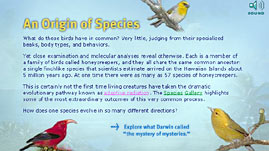The term
evolution refers to the cumulative change that occurs in
populations of organisms over time. Sometimes evolutionary change is so
dramatic that different populations of the same species diverge to become
two or more distinct species. In the case of a group of birds called
honeycreepers, for example, a single species that colonized the Hawaiʻian
Islands about 5 million years ago ultimately diverged into 57 different
species.
This process, which evolutionary biologists call
speciation or adaptive radiation, can happen anywhere. However, it is
most clearly demonstrated on geologically young land masses, such as
newly formed islands or mountains. In these environments a population
of organisms will typically find a set of environmental opportunities
and pressures very different from the conditions they experienced
in their place of origin. These environmental differences come in
many forms and often cause sweeping evolutionary changes in a founding
population.
Several environmental factors affect the process
of speciation. The structural habitat of an area determines the ease with
which creatures are able to move around and find shelter from weather
and other organisms. Food, both the type and its availability, dictates
the ease with which animals are able to acquire the energy they need to
survive and reproduce.
Competition for various resources
is another factor that can drive the process of speciation. Competitive
pressure can come from organisms of the same species or from organisms
of different species. Generally, in highly competitive environments,
traits that minimize competition — traits that, for example, allow two
different populations to feed on very different types of food — are
advantageous.
Another factor that can influence speciation
is predation. Predators typically reduce the rate of speciation because
they limit other organisms' access to resources. On newly formed land
masses, however, the number of predators is typically lower than on
older continents. These younger environments, therefore, provide more
opportunities for species to evolve into new and different species.


 Loading Standards
Loading Standards Teachers' Domain is proud to be a Pathways portal to the National Science Digital Library.
Teachers' Domain is proud to be a Pathways portal to the National Science Digital Library.
